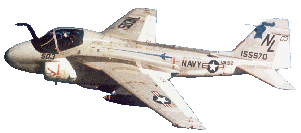
“STAND BY,” said Lt. Paul Smyth emphatically.
Copilot Lt. Rich Leonard followed calmly: “Standby, we have a problem
right now.”
It was February 22, 1978, around 2:35. p.m.![]()
Awaiting clarification, the radar
controller aboard the USS Kennedy
tracked the KA-6 Attack Bomber on
his scope. The Kennedy was about
100 miles off Norfolk, Virginia. The
bomber, “Fighting Tiger 524,” had
taken off from NAS Oceana,
Virginia, about 20 minutes before,
with orders to land on the carrier. It was presently following its
vector of 270o due west in preparation to come around for
landing. It was only about 30 miles away right now, at 14,000 feet.
The Plot was about to initiate contact when suddenly Fighting Tiger
524 vanished from the scope.
“524 radar contact lost.”
![]() There was no response. A few minutes later the radar controller repeated. There was still no answer. The supervisor then placed the DOWN AIRCRAFT symbol on the NTDS radar scope, alerting all controllers aboard Kennedy to a downed aircraft. As soon as this appeared in CIC, the strike controller noted a raw radar return. It was identified as an aircraft track. It was about 12 miles southwest of Fighting Tiger 524’s last position, heading now 220o. However, it had no IFF signal. It lasted for a short while, then disappeared. If it was 524, neither pilot made contact in those minutes it was being tracked
There was no response. A few minutes later the radar controller repeated. There was still no answer. The supervisor then placed the DOWN AIRCRAFT symbol on the NTDS radar scope, alerting all controllers aboard Kennedy to a downed aircraft. As soon as this appeared in CIC, the strike controller noted a raw radar return. It was identified as an aircraft track. It was about 12 miles southwest of Fighting Tiger 524’s last position, heading now 220o. However, it had no IFF signal. It lasted for a short while, then disappeared. If it was 524, neither pilot made contact in those minutes it was being tracked
An immediate search found no trace of the aircraft. The sea had been choppy, but the sky was clear— 15,000 feet cloud tops; haze layer at 17,000 feet.
There is no explanation for what happened to the KA-6 Attack Bomber. It had vanished and then it had returned. During the time it had vanished, it apparently had lost its IFF signal and radio communication ability. Added to this electronic mystery is the failure of ejection signals. Ejection would trigger emergency beacons, one in each seat. This signal would lead rescuers to the accident point where ejection took place. The sequence of events show the pilots had more then enough time to clarify the situation (providing they understood it) and more than enough time to eject after seeing all was lost. The failure of these electronic devices made the investigation conclude:
Opinion: Cause as to the loss of AB524 and the subsequent deaths of LT. SMYTH and LT. LEONARD is unknown. It is evident that two minutes prior to AB524’s disappearance, the crew was having some difficulty or experiencing a minor emergency as revealed by the voice tape transcripts. Due to the lack of further radio transmissions, no hypothesis can be made as to the type or severity of the initial difficulty. It is suspected, however, that a catastrophic situation developed after the final radio transmission and LT SMYTH and LT LEONARD were incapable of coping with the situation. It is further believed that the crew did not attempt to eject as the concurrent failure of both URT-33 beacon radios was unlikely. Thus, this investigation concludes that a catastrophic emergency situation developed, incapacitated the crew to the point that they were unable to eject and were subsequently lost at sea.
For an explanation of why an incident off Norfolk is considered part of the Triangle, go to the following link.
“Fighting Tiger” 524